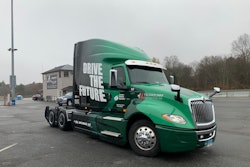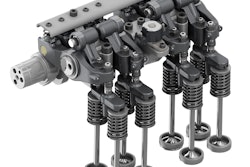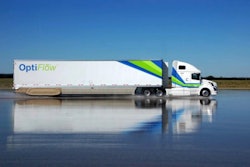Jacobs Vehicle Systems provides a closer look at how Cylinder Deactivation (CDA) and Active Decompression Technology (ADT) improves emissions, fuel economy and driver comfort in an International LT625.
Jacobs reports that CDA, equipped with Dynamic Skip Fire software from Tula Technology, can cut fuel consumption by up to 25% while slashing NOx 77% and carbon dioxide by 13%.
A display screen inside the LT625 shows when CDA activates and deactivates engine cylinders as the driver accelerates and decelerates the truck at the Thompson Speedway Motorsports Park in Thompson, Connecticut.
 The display screen showing how Jacobs Vehicle Systems' cylinder deactivation shuts down all six engine cylinders. The fuel-saving measure also slashes emissions.Commercial Carrier Journal
The display screen showing how Jacobs Vehicle Systems' cylinder deactivation shuts down all six engine cylinders. The fuel-saving measure also slashes emissions.Commercial Carrier Journal
“You can see when we’re decelerating, we have zero cylinders active,” Justin Baltrucki, principal engineer at Jacobs Vehicle Systems, explains as he takes his foot off the pedal when driving the truck towards a turn.
Conversely, various cylinders are activated (look for the green lights illuminating on the display in the video at the top) as Baltrucki presses the accelerator to power the truck ahead.
[Related: Engine brakes changing to meet greater variety of engine types]
Testing over the past four years has shown “up to 12% fuel economy savings,” explains Rob Janak, Jacobs’ director of new technology.
Jacobs also demos active decompression technology (ADT). Janak points out how ADT can eliminate cab shake to help drivers get better sleep when their trucks start and stop periodically to charge batteries needed to keep HVAC systems up and running.
ADT requires less powerful starting systems and, like passenger cars and pickups on the road today, paves the way for a fuel-saving “auto stop-start system,” Janak says.
Contents of this video
00:00: Intro and interview with Rob Janak, director of new technology at Jacobs Vehicle Systems, who explains cylinder deactivation (CDA)
00:37: Steve Carlson, vice president of Dynamic Skip Fire at Tula Technology, talks about software role in CDA
01:10: Justin Baltrucki, principal engineer at Jacobs Vehicle Systems, explains CDA display metrics in truck demo
01:25: Janak explains why CDA works best under low load 01:41: Carlson describes how CDA deactivates cylinders
01:54: Baltrucki’s truck demo shows CDA under deceleration vs. acceleration
02:39: Janak talks fuel economy an NOx improvements with CDA
02:58: Carlson talks meeting EPA’s 2027 emissions regs with CDA
03:31: Active Decompression Technology (ADT) intro
03:50: Bob LeBlanc, warranty manager at Jacobs, demos ADT
05:30: Janak explains benefits of ADT
Video transcript
Rob Janek (00:12):
Hello. My name is Rob Janek. I'm the director of new technology at Jacobs Vehicle Systems. We're here at the Thompson Speedway to do our cylinder deactivation and active decompression testing and demonstration.
(00:22):
This is technology that we created cylinder deactivation primarily for improving the thermal management of the engine. Thermal management allows us to lower NOx, lower the criteria pollutants coming out of the after treatment system. But we can do that also with improving the fuel consumption. We actually lower co2.
Steve Carlson (00:37):
Steve Carlson from Tool of Technology. We're a software company that provides whole software implementation for cylinder deactivation. We're here today to demonstrate dynamic skip fire and cylinder deactivation with Jacobs.
Justin Baltrucki (01:09):
On the display here you can see the torque that we're running. We don't really run the CDA until we're down under 500 newton-meters, but you can see when we're decelerating, we have zero cylinders active.
Rob Janek (01:24):
Cylinder activation is not a technology that's really deployed too much on the high load conditions, so it's not a performance improvement on that side. This is all about when the engine power isn't needed, so fleet runs that are using diminishing loads, return home to base empty, then the idle conditions is when cylinder de activation is used.
Steve Carlson (01:40):
When you get to that low load, it's still pumping six cylinders worth of air through the after treatment system. With the deactivation, you can shut down the other cylinders that aren't needed and supply the power needed with maybe two, three or four cylinders.
Justin Baltrucki (01:54):
Again, as we coast, we go to zero cylinders and you can see the temperature very slowly decreases. Whereas in six cylinder operation, you're pumping a large volume of cold air through the after treatment. The goal of CDA is to try to prevent that cool off that occurs so that the heat generated during the high load operation can be maintained and you can keep that SCR system in an efficient temperature.
(02:21):
The other benefit from the zero cylinder motor, you might notice the truck doesn't really slow down much. We have a much lower motoring friction on the engine. With that you'll see a real world benefit. It's like reduced rolling resistance. You'll see a real world benefit from that that's not shown on an engine Dino test.
Rob Janek (02:38):
The testing that we've shown and we published in the past four years so far is we showed in a low load cycle that's one of the certification cycles that are in the market now, we can show up to 12% fuel consumption savings while still reducing NOx to, I think it was over 80%. Even in FTP cycle, we showed between 3% and 5% fuel savings at the same time of reducing NOx.
Steve Carlson (02:58):
Some of the benefits that we're finding with this is really to focus on the 2027 emission regulation reduction, which is a NOx reduction largely.
Rob Janek (03:07):
But at the same time, there's already existing yield that are on greenhouse gas, which are about reducing co2, improving fuel consumption. Those both have to happen at the same time just on different schedules, so technologies that can do both, fuel consumption saving and can raise temperatures or improve the after treatment system is what's needed.
Steve Carlson (03:31):
The second technology is active decompression. That allows us to decompress the engine that gets rid of that shake as the engine shuts down and also improves the start ability of it. We're hoping that's going to improve the acceptance of stop start because we reduce the wear out of the start and stop of the engine. So we get rid of idly whenever it's not needed.
Bob LeBlanc (03:50):
My name's Bob LeBlanc. I'm the warranty manager in North America for Jacobs, and I'm also the test development truck driver. Today we're going to demonstrate our ADT. Currently we have it deactivated. This is going to be the standard engine shutdown that we're going to demonstrate. You can hear the rattle and the shaking and the roll of the chassis.
(04:11):
Then on standard startup, you're going to hear the standard engine starting up under compression and so on. Here we're just going to activate it. This is now with the system activated and you're going to feel a very smooth wind down of the engine and there will be no shake of the cab. Then on startup, you're going to hear a small whine and you're starting the engine under with no compression and therefore there's a less load on the starter, less load on the batteries, and so on.
Rob Janek (05:31):
It's the sleeper cab. When the truck has to auto start in the middle of the night to recharge the hotel batteries, when it shuts down that death rattle, that shake gets quite extreme, it can actually wake up a truck driver so that's how that system was originally developed was to actually get rid of that shake. It was through the development of it and the testing that we proved out that we could actually improve the startability and the cold start, all those extra benefits that allowed us to maybe promote this as a stop start system.










